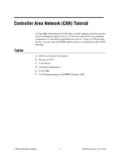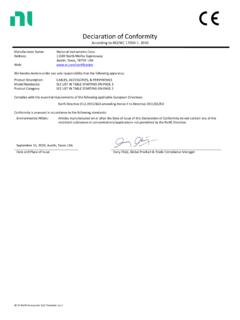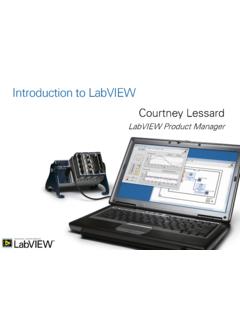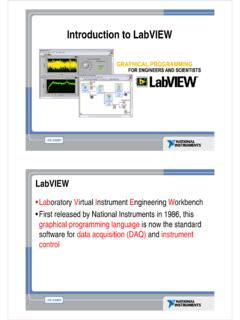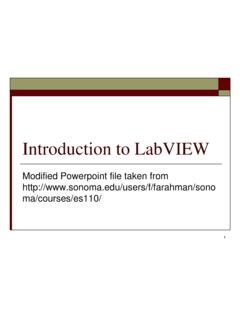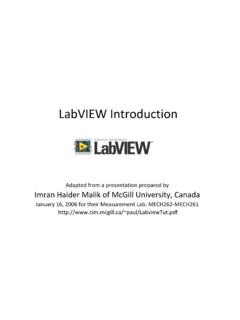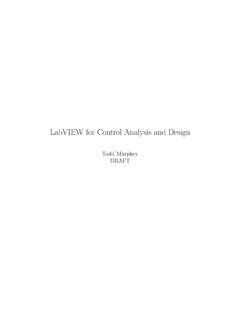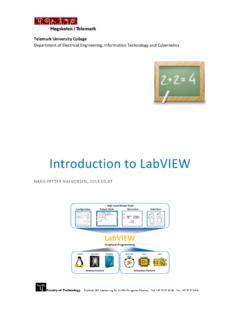Transcription of Introduction to LabVIEW - National Instruments
1 EE100 Bharath Muthuswamy 1 Introduction to LabVIEW 1. Introduction Welcome to the LabVIEW component of EE100! This lab is just a simple Introduction to the graphical circuit simulation software called LabVIEW I. Introduction to Graphical Circuit Simulation using LabVIEW (ref: EE1 LabVIEW Experiment, Spring 2004) Graphical circuit simulation software, such as LabVIEW (we will be using LabVIEW version ), is popular among engineers working in the industry and researchers in universities and research labs because it reduces the testing and manufacturing costs. In the lab 2, you will see the real power of LabVIEW . You will use LabVIEW to sweep the frequency of a sine wave from 20 Hz to 20 KHz and plot a graph automatically.
2 Compare this to the tedious process of sweeping the frequency manually using the function generator, noting down values and then plotting the graph by hand! LabVIEW is a graphical programming language that shares some aspects with traditional non-graphical programming languages (C, Pascal etc) and some aspects of hardware definition languages (VHDL, Verilog). Namely, it combines the generality and power of traditional programming data structures such as loops, if-then branches, and arithmetic operators with the ability of hardware definition languages to perform multiple tasks simultaneously. Programming in a graphical environment consists of placing functional blocks that perform specific tasks on a worksheet and wiring them together to send data from one block to another.
3 These blocks can do anything from simple tasks (add the data on two input wires together and place the answer on the output wire) to complex tasks (take two arrays of data as input and display the contents on a log-log graph as x,y pairs). These functional blocks can also translate data in the graphical program into a form that external equipment can use. LabVIEW helps introduce the power of computers in engineering today. Although you are not an electrical engineering major, you will use computers for simulation and testing in your major. LabVIEW can be used to control any instrument that complies with the IEEE standard, using GPIB General Purpose Interface Bus. You may find one of the devices in your lab can be actually controlled using LabVIEW ! In this lab, you will be introduced to the world of LabVIEW using National Instruments (the company that designed LabVIEW ) very own training materials.
4 You will understand LabVIEW terminology like VI (Virtual Instrument) and block diagrams. In this lab, you will not be designing the functional blocks mentioned earlier. This is to ease your Introduction to LabVIEW . EE100 Bharath Muthuswamy 2II. The Lab 1. In order to complete National Instruments 3-hour tutorial, you need access to the internet. Although you can do some of the exercises from home, you need to use the computers in your EE100 lab for access to the DAQ (Data Acquisition Module). If you want to use the lab, you can find login and password information in the lab check with your TA. If you want to work from home, you can connect with the LabVIEW terminal server: a.
5 Go to b. Type as the server. Please note: you may need to install a Microsoft component for using Windows Terminal Server. Also, I have tested these instructions on a Windows machine. I don t know if they will even work from other OSes my guess is a no. c. Click no Connect. A login screen should pop up. LOG IN USING YOUR EE100 STUDENT ACCOUNT IN THE EECS DOMAIN, NOT THE KRAMNIK DOMAIN. 2. Visit the LabVIEW homepage ( ~esg/ LabVIEW ) and click on References. You should always refer to this homepage first if you have questions on LabVIEW . 3. Click on Three Hour LabVIEW Introduction for Students 4. Follow the Introduction and complete the LabVIEW exercises.

